 We’ve already published one article about Claire Fraser’s stage outfits (you can read it here). But one material is way not enough to show all of her marvelous Scottish costumes filmed in the “Outlander” movie, in Season 1. So, we’ve made another one. You’ll be able to see many Claire’s tartan attires, her striking wedding dress (and find out what gown has inspired the costume designer on creating it), her diverse underpinnings, and even a men’s costume on her. We will reveal some secrets of making Claire’s costumes and also difficulties that the wardrobe team had.
We’ve already published one article about Claire Fraser’s stage outfits (you can read it here). But one material is way not enough to show all of her marvelous Scottish costumes filmed in the “Outlander” movie, in Season 1. So, we’ve made another one. You’ll be able to see many Claire’s tartan attires, her striking wedding dress (and find out what gown has inspired the costume designer on creating it), her diverse underpinnings, and even a men’s costume on her. We will reveal some secrets of making Claire’s costumes and also difficulties that the wardrobe team had.
Read also:
Stage costumes of Outlander series. Scottish outfits of Claire Fraser in Season 1
Stage costumes of Outlander series, season 1. Scottish folk clothing on Jamie Fraser
Stage costumes of Outlander series. Women’s Scottish outfits used in this movie
Stage costumes of Outlander series. Men’s Scottish clothing used in this movie
This material is based on the video from a YouTube channel “Costume CO”. A dress historian and material culturist Brenna Barks also helped to create this analysis. Another expert is Sandie Russo from “Knitzy Blonde”, who has created some of the Outlander knitted garments.
One of Claire's most highly coveted dresses is this tartan gown with a contrasting embroidered silk under petticoat and stomacher from the 4th episode called “The Gathering”.
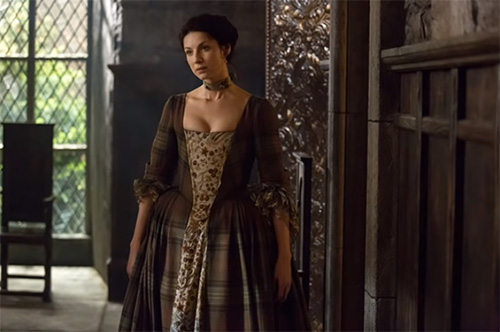
The costume designer Terry Dresbach explains on her blog that the wardrobe crew were under the gun to get the dress done on time and that it was further complicated by actor Caitriona Balfe’s shooting schedule.
And one of the most challenging aspects of costuming is getting the actor in for fittings.
Terry Dresbach explains it this way, “When you make a dress, first you make a toile, a dress out of muslin. That is to fit on the actor and work out any kinks, make any changes. It's a rough draft. Then you make it out of the actual fabric, and you need two fittings, one to make sure it is all going well, now that you are in fabric, and then a final fit, just to double-check everything. And then you need the time in between fittings to do the actual work. So, it takes 2-3 weeks, with the fittings interspersed”.
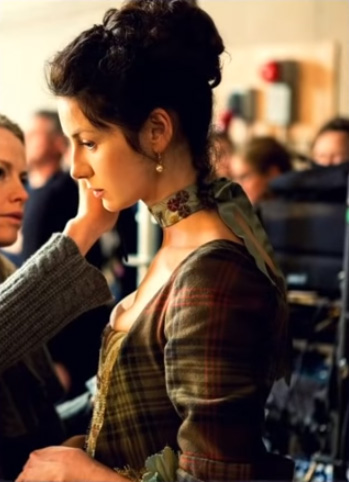
Dresbach also describes the mad scramble to get the fabric in time, “You pick ten fabrics, call the mill, and see what they have in stock. That takes a while, because they aren't on film business schedules. And the embroidered fabric. I had bought a meter of embroidered silk in London. I liked it, but wasn't totally sure about it, and I didn't know what tartan I would end up with. But when the tartan finally came in, it was a pretty good match with the embroidery. But when we called the fabric store, they were all out”.

In the end, the London shop was able to locate more of the embroidered silk fabric in India.
For the final costume, Terry Dresbach went with a metallic-gold Chantilly lace for the trim and inner sleeve ruffles. In this image, you can see that the scalloped edge of the silk has sheers.
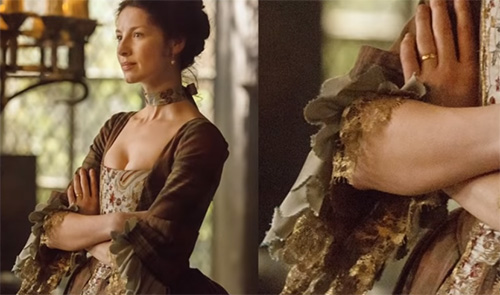
Here's a studio shot of the gown.
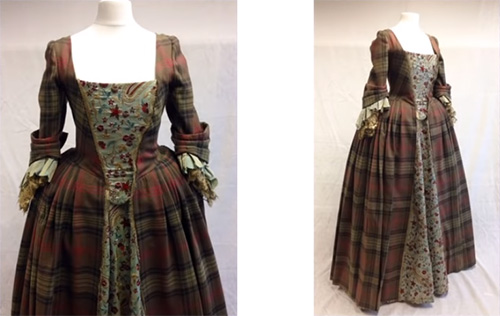
Dresbach said of the final look, “I love the combination of plaid and flowered embroidery. You can find that kind of mix, often in the 18th-century peasant costumes, but I took the leap that they might have had that in Scotland. I think it works. I like the dress, but it was definitely a product of circumstance. Made by master craftsmen, but hampered by the growing pains of the show”.
According to Terry Dresbach, Claire's tweed slightly asymmetrical riding coat that she wears in Episode 4 and 5 was born out of necessity. “We didn't plan on it, but it was so bitterly cold, and Cait [Balfe] had been through so much wearing that shift, I just couldn't send her back out into the freezing winter, without something very seriously warm. So Mrs. Fitz went back into her trunks and dug up this coat. It is very, very warm, and our girl was very, very warm”.
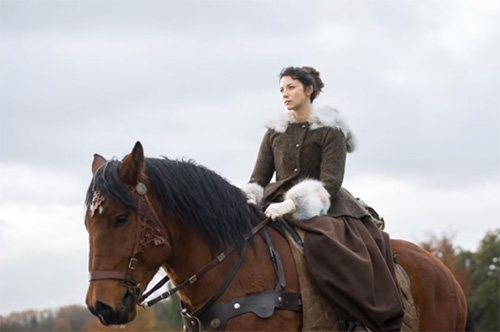
It's sort of an inside joke, but Dresbach often calls on Mrs. Fitzgibbons, who is the head housekeeper at Castle Leoch, to dress Claire from her many trunks of clothes.
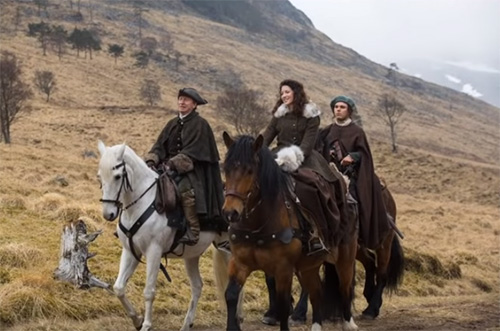
The tweed coat has a generously deep hood that's trimmed with fur. Also, the coat is cut similar to a caraco, which is, essentially, a hip-length coat. And the coat has inverted box pleats that give the skirt its fullness.
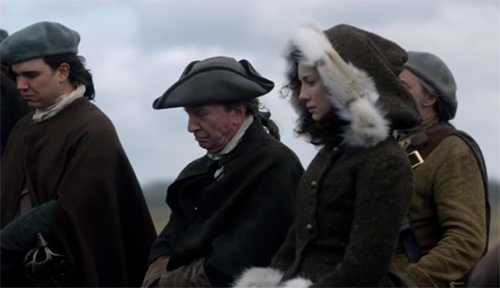
Here are a few examples of 18th-century riding jackets that, Dresbach says, inspired the silhouette of Claire's coat.
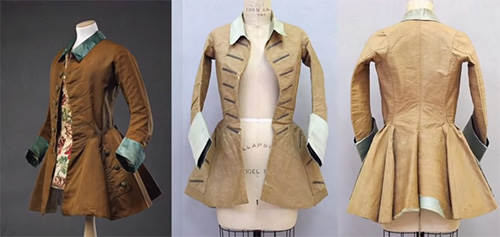
The 1740s coat on the left is made from worsted wool and it's trimmed with brocaded silk and silk satin. According to The John Bright Collection that owns this coat, this lady's riding jacket is based on the cut of men's coats of the time. The fullness of its skirt and it's hard wearing fabric make it a very practical garment which, together with a matching petticoat or skirt, could also be worn for traveling.
And the 18th-century wool and silk coat on the right is cut in much the same way. This French riding coat is from The Met.
This worsted wool British riding coat dates between 1750-59, and it's from the V&A. The coat is lined with linen and silk. While the first two coats are meant to be worn open with a waistcoat, this jacket, like Claire's, is fastened at the front with buttons.
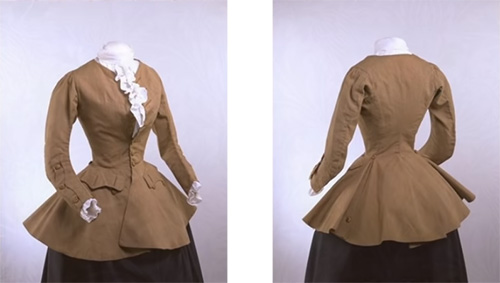
The collar and cuffs appear to be trimmed with rabbit or fox fur, although it might be real or faux fur. And the coat itself appears to be a Harris Tweed. And actually, such fabrics are too heavy for the time. So Harris Tweed wasn't really a thing until the 19th century.
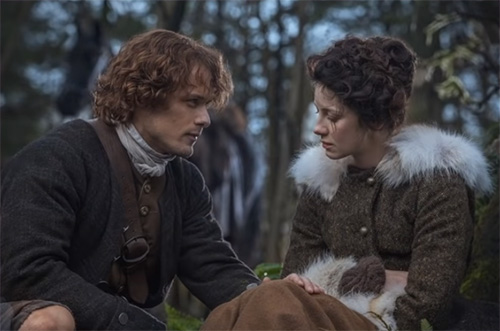
Terry Dresbach said, the gloves are made with kid leather, and they printed stag antlers on them in honor of the MacKenzies.
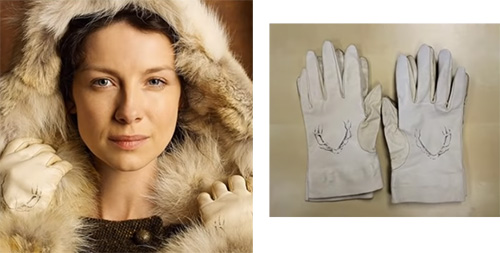
Here's an example of gloves from the period that are on display at The Met. These British leather and metallic gloves are from the early 18th century.
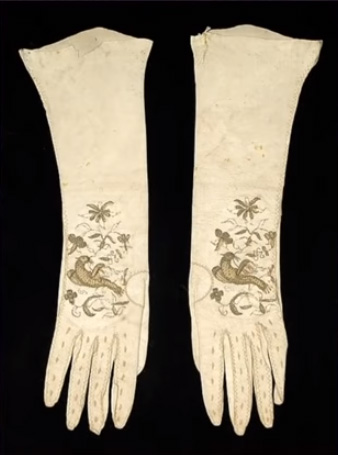
Here is Claire's full-length hooded cloak from the Episode “Both Sides Now”. The wool cloak is lined with tartan fabric and fastened at the neck with a giant hook. From a historical perspective, Brenna Barks states, “Largely what we see in the mid-18th century is the arisaid and that was among the poorer and working classes. Cloaks would have been made of the usual fabrics, usually wool”.
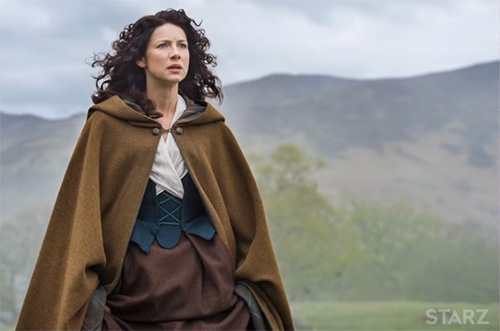
Brenna says that, while women do wear cloaks in the 18th century, “It's hard to find surviving examples, since outerwear would suffer more wear and tear than the garments that are usually preserved”.
This is a rare example of a mid to late 18th-century cloak from the Colonial Williamsburg Museum. This red wool broadcloth cloak is English and it's lined in dull red silk.
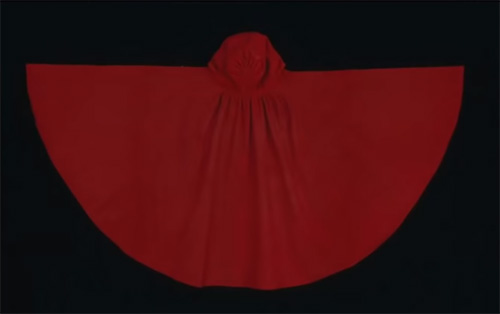
Here's another example of a wool cloak dating from the last third of the 18th century. According to The Met where the cloak is displayed, this particular type of cloak, called a “cardinal” because of its color, is made of a closely woven wool, cut on the bias, and left with a raw edge along the hem.
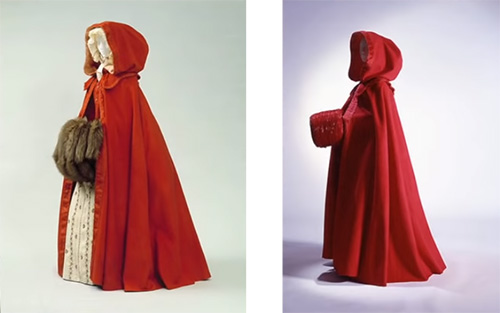
Brenna Barks says in her article, “There's also the fact that tartan, essentially an expensive fabric, is used to line Claire's cloak. You don't hide fabrics that expensive – at least not in the Highland culture, which was rather flamboyant”.
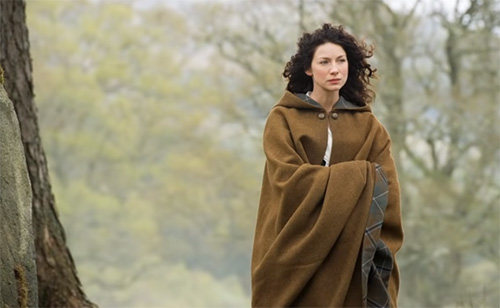
And according to Gordon Kirkbright, the designer of the Outlander tartan, the lining is Douglas Weathered Tartan.
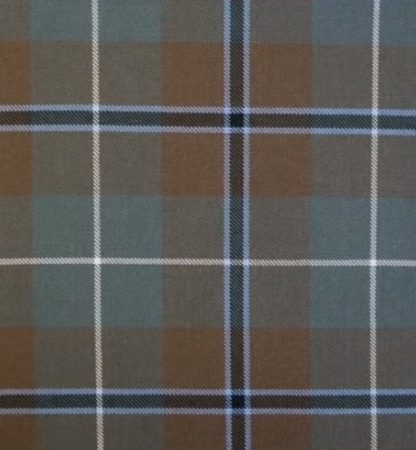
The cloak is cut in a circle, but there are darts at the shoulders for a bit of shaping. And if you look closely, you will see that the hem of the cloak is distressed.
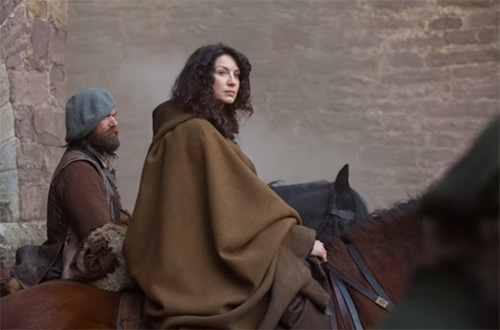
Like Claire's riding coat, the two-piece hood is cut very generously.
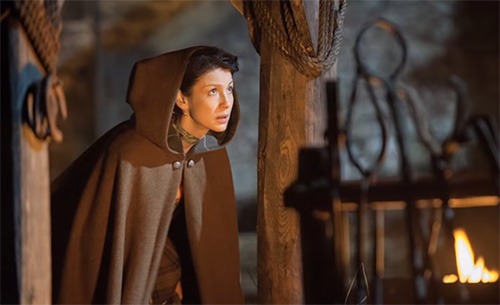
Claire wears this lovely green tartan dress in Episode 5. The dress features a bodice with three-quarter length, slightly bell-shaped sleeves with a simple linen ruffle insert and a fully pleated skirt.
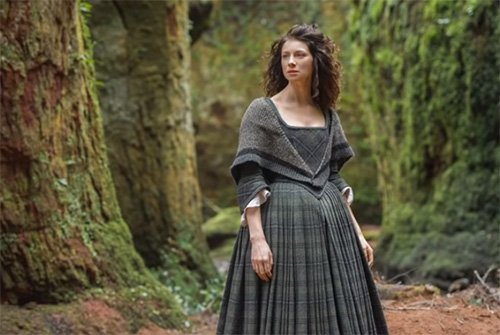
Here's a good close-up of the bodice. The stomacher portion is cut on the bias and it appears boned at the center front. And the neckline is trimmed in matching braid.

Claire wears the dress once again in Episode 7.
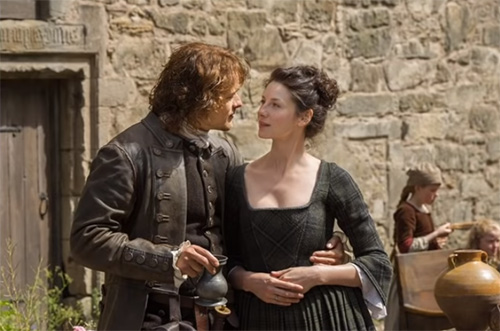
Here's a great side view. The shelf is created by the bum roll under the dress. In this picture, you can see the skirt pockets.
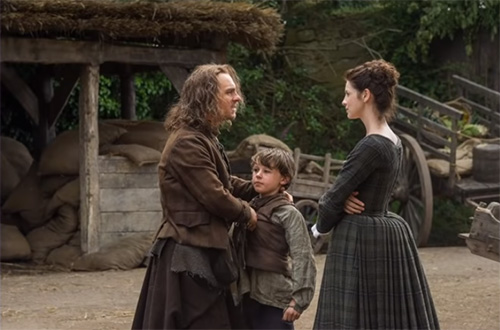
Here's the dress from an Outlander exhibit.
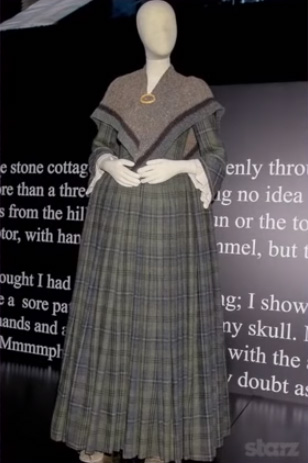
Claire adds this lovely knit shawl in Episode 5.
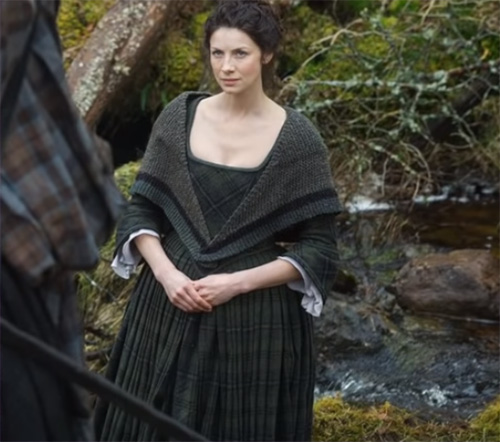
According to Knitzy Blonde, the red shawl is a garter stitch triangle-shaped shawl that uses a technique called “intarsia” for doing the different colored stripes.
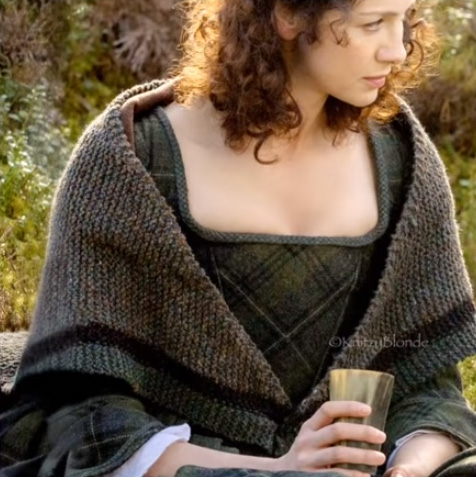
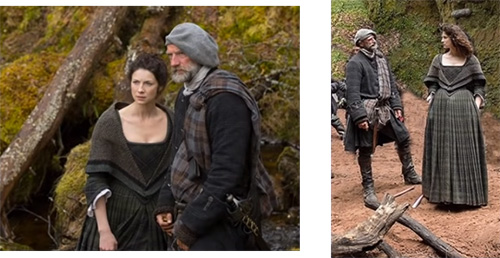
In Episode 7, Claire wears this stunning wedding gown in her marriage to Jamie.
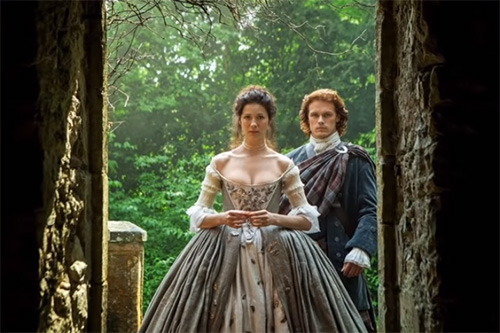
In one of the very rare occurrences in cable television, the production of “Outlander” managed to get some excellent shots of Claire in really good light.
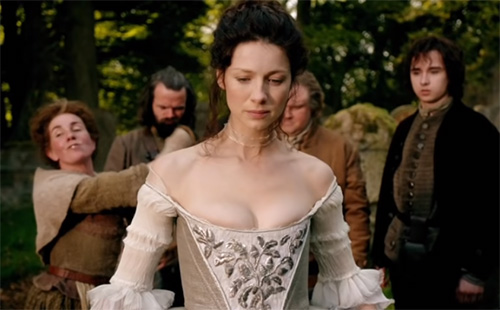
They even went so far as to do a reveal of the gown in a full head-to-toe shot so that we could see all the detail on the bodice and embroidery that carries down into the underskirt.
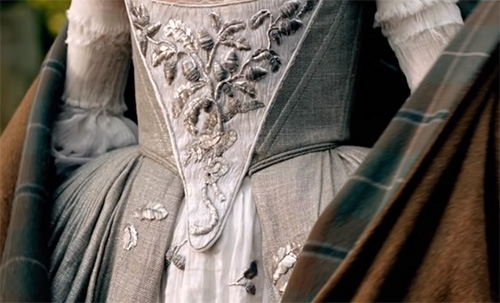
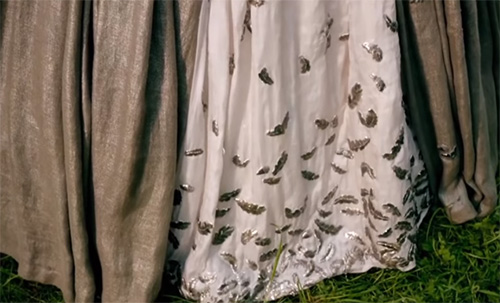
Liz Boulton, costume maker and embroiderer for three seasons of Outlander, says that this technique is called “silver plate embroidery”.
Here, of course, is an excellent head-to-toe studio shot of actress Caitriona Balfe and Sam Heughan in their wedding finery.
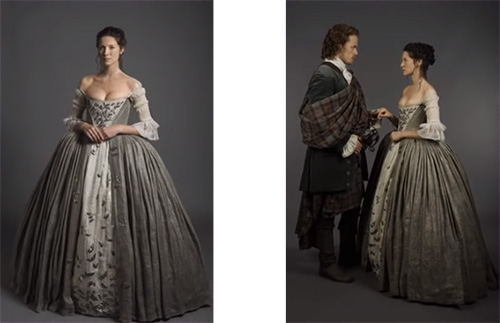
Brenna Barks says that Claire's 18th-century wedding gown was inspired by this extraordinary Sophia Magdalena, Queen of Sweden wedding gown from 1766.
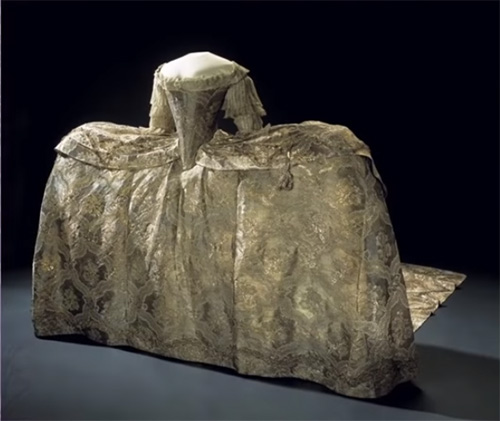
The style of wedding gown is the so-called “Robe de Cour”, meaning “court dress”, and it's sewn according to current French fashion of the time. The origin of the costume has long been unknown, but it's thought that the costume was sewn in Copenhagen with fabric purchased in Hamburg. The bone bodice has an extremely tapered waist.
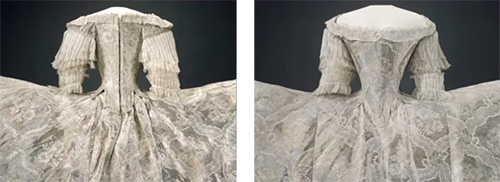
On the left, is the silver brocade that's patterned with flowers and leaves. The sleeves are removable, made of several layers of thin patterned gauze called “engageantes”, meaning “false sleeves”.

The rigid bodice is heavily boned and fastened at the center back with lacing through 13 hand-worked eyelets on either side.

Here are some close-up images of Claire's wedding gown, taken from Terry Dresbach's blog. The bodice is laced at the back through rings rather than grommets, and lightly boned. The fullness of the skirt comes from these densely folded cartridge pleats, attached to the waistband of the overgown.
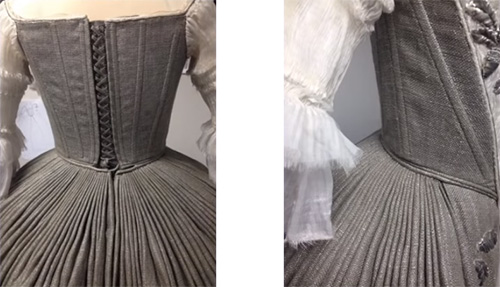
Pictured are thin shavings of mica mineral from Dresbach's blog. Liz Boulton reveals, “I showed Terry samples of the metal threads, spangles, hotfix rhinestones, hotfix pearls, metal foils and foiling, angelina fiber and mica powders. Then I showed her a picture of a 17th-century box covered in sheet mica and brought my stash of mica in to show her”.
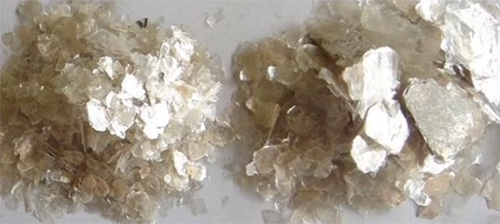
Terry Dresbach comments, “We all took turns shaving mica during stressful times. It was a very zen activity, chop wood, carry water. Saved our sanity. We started with three chunks of mica about 4 inches long by 3 inches thick. We shaved them down to a large container of paper-thin flakes”.
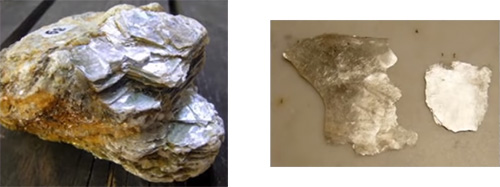
Liz Boulton adds that the mica slivers were glued onto a cream layer, below the shear layer, with the silver embroidered leaves, like we see here on the stomacher portion.
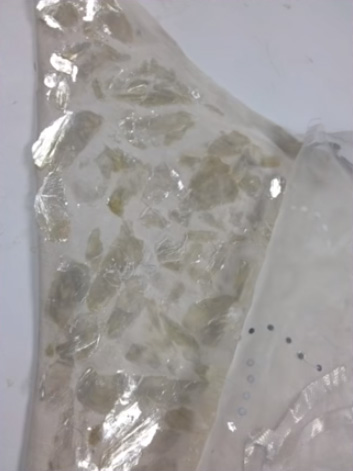
Here's a picture of the smocking technique of the sleeves. Terry Dresbach said, “We had this beautiful little smocking machine that operates with a ham cranks and makes beautiful magical things”.
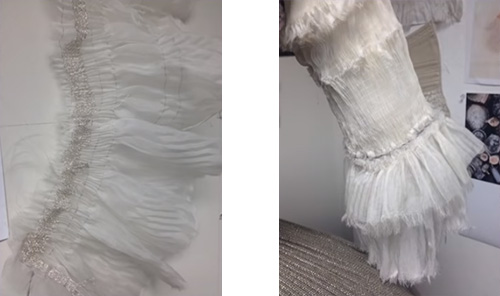
And on the right, is a picture of one of the completed sleeves.
Of the silver embroidery, Dresbach said, “We made hundreds of leaves and acorns, all by hand. You can see the metal strands very clearly, it is an amazing process. Extraordinary work!”
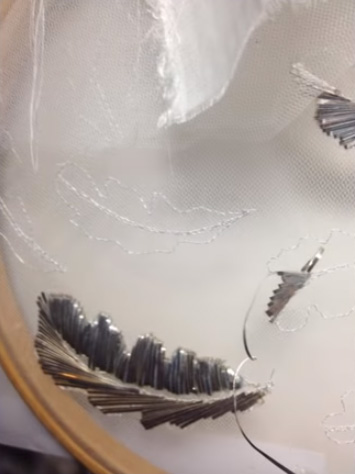
And then Liz Boulton adds, “We stitched the leaves and acorns on net so we could start producing the embroidery before the dress was made, it also gave us the freedom to have many people embroidering at the same time, the “slips” (as embroidered motifs to be applied are called) could be positioned wherever we liked and the breaking down process for the embroidery wouldn't be directly onto the dress fabric”.
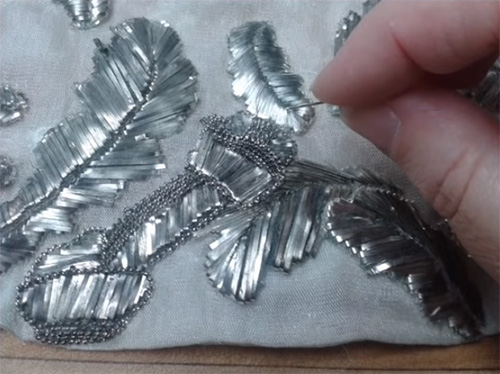
“There were 6 people embroidering leaves and acorns over 6-8 weeks and I embroidered the stomacher myself over about a week. Once the embroidery was done, the individual slips had to be aged with dye and breakdown and then they had to be hand-sewn to the gown”, says Liz Boulton.
One of the most challenging aspects of working on the gown, she says, “… was probably to work on how to make the 3D stems and ribbons for the stomacher using very fragile strips of metal – the more embossed they are, the easier they are to snap!”
Liz Boulton also remembers, “… after researching supplies and ordering supplies and going through the sampling process for the embroidery. Terry decided on plate embroidery for leaves and acorns, using a little Pearl Purl (a stiff spring of metal thread cut and used like a flexible bead) for the acorn cups, with different textures of plate used for the stems and ribbons on the stomacher”.
Of this close-up of the completed stomacher from her blog, Terry Dresbach said, “All the leaves, stems, and acorns have been painted to look as though they've oxidized, giving them lovely tone and depth. This stitching or smocking on the silk reflects the stitching done on the sleeve. Just stunning work by my amazing crew”.
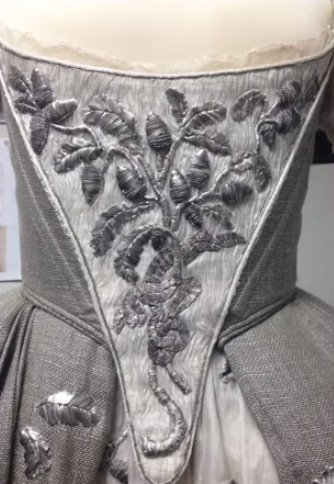
The next most important aspect of Claire's wedding ensemble, of course, are her gorgeous underpinnings. It's important because her low neckline of the gown is contingent on the silhouette of her strapless stays.

The stays are worn over a very sheer shift. This one might be silk and it's worn under her petticoat.
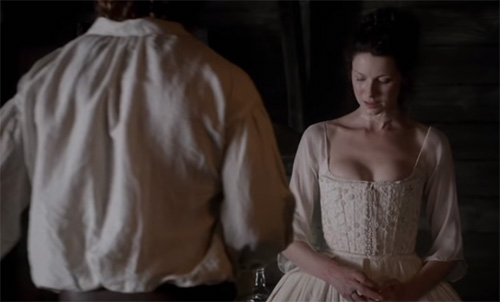
This picture features the beautiful quilted band on the bottom of the petticoat.
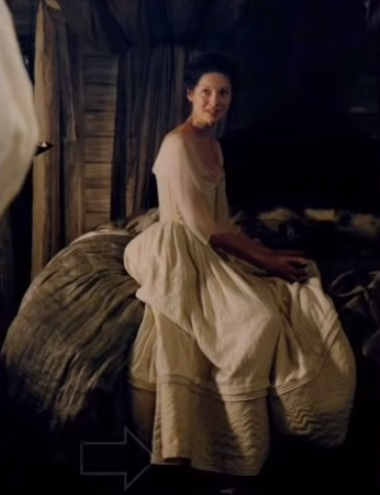
Here's a shot of Caitriona Balfe during a fitting or for a continuity picture, wearing just the shift and the front-lacing stays. The stays’ fabric looks like it's floral & leaf whitework embroidery.
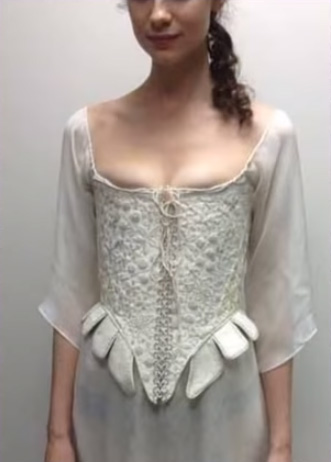
There's also this pretty embroidery, bordering the petals. The stays are laced through these metal rings, like we also see on her wedding gowns, that are stitched on one side of the ring with very tiny stitches.

For historical reference, here's an example of lady’s French silk brocade stays from Augusta auctions that date from 1700-1720. These stays feature metal eyelets that lace the panels together.
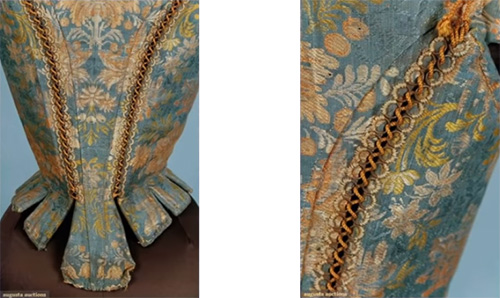
In the Episode “By the Pricking of My Thumbs”, Clare wears this silk brocade gown. Terry Dresbach states on her blog, “Anyway, this dress was one of the first costumes I got really excited about. We finally had a permanent and very talented cutter, our third in about two months. The result was very exciting”.
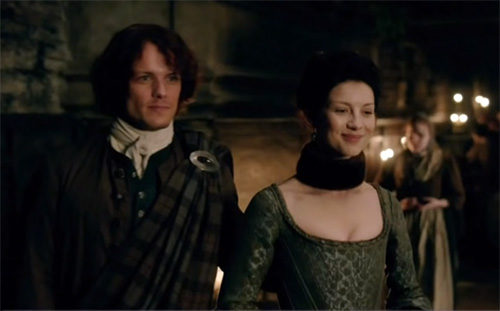
The gloomy interiors of the castle do not favor for dresses like this. It just makes the motif on the gown look muddied.
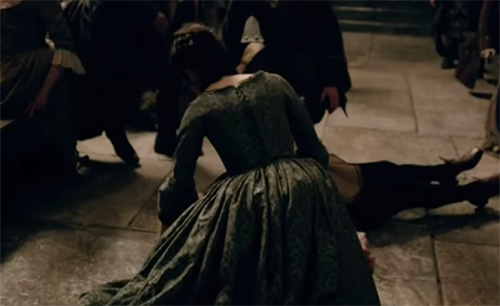
Dresbach has also added this fur ruff and cuffs to the dress.
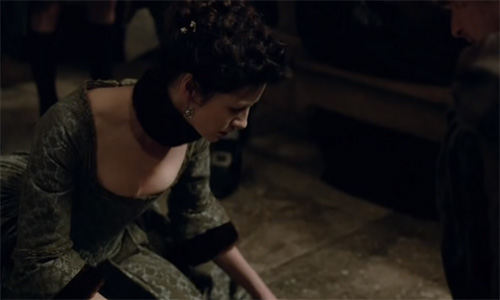
Here's a better shot of the gown in this behind-the-scene image.

In these mannequin shots from Terry Dresbach’s blog, you can see that the woven fabric is actually a gray-green background with a golden leaf motif. The thread, creating the bone channels, looks white but that might just be from the flash.
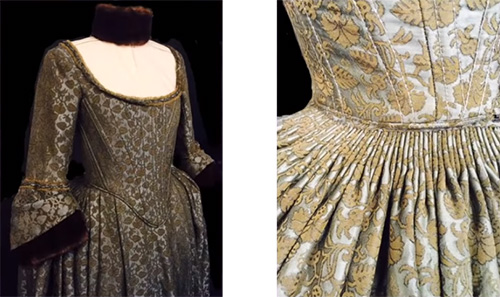
The bone channels and back lacing are identical to her wedding gown, as is the cartridge pleated skirt.
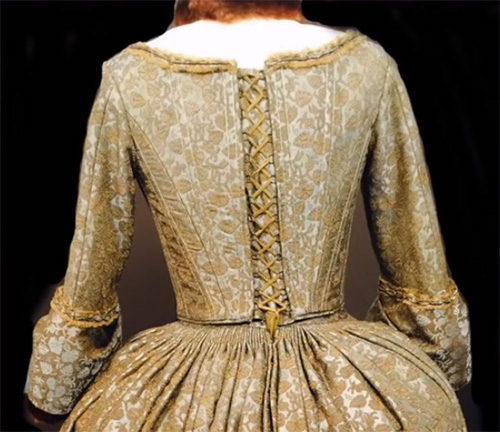
Terry Dresbach was excited to finally get Claire in a plaid or arisaid.
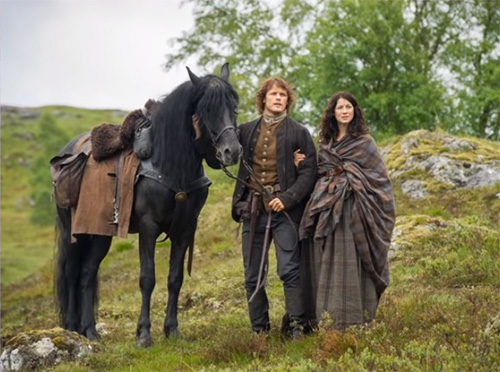
Brenna Barks says, “I think most women would have worn a plaid of some sort – plaid is not necessarily a tartan piece of fabric but can simply mean a large width of cloth or blanket. So even if they couldn't afford a tartan arisaid, they would have had one of plain material. It served as a sort of coat/cloak”.
And Dresbach said, “It went against everything that you are supposed to do on a lead actress, any actress, any woman, really. A giant piece of tartan wrapped around a giant plaid skirt that is worn over a padded roll, designed to make your hips look wider???? And then you belt it all in the middle with a man's belt?”
And for reference, pictured on the left, is “A Town Lady” by James Basire from 1745, showing the arisaid worn draped over the head as a shawl. And on the right, is a section of an illustration from 1760 (which is a little bit later) that was taken from “Letters from a Gentleman” in the north of Scotland to his friend in London, with a woman pictured in the center also wearing an arisaid.
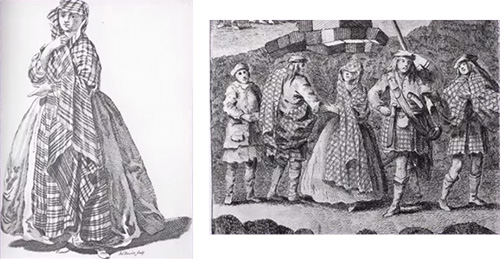
Brenna Barks comments, “Just because this is the traditional way of wearing it, doesn't mean women weren't creative – but they might not have had a leather belt. As I said previously, leather was expensive and belts were not typically a part of women's attire at this point, at least not the sort Claire is wearing or how she is wearing it. It's a very modern way of doing it, and one which lends itself well to the current blanket-scarf trend, something television and film designers need to be savvy about”.

This is a really lovely Claire's juggler costume from Episode 14. It includes a man's embroidered coat and hand-painted waistcoat, linen shirt, trews, and a tricorn hat.
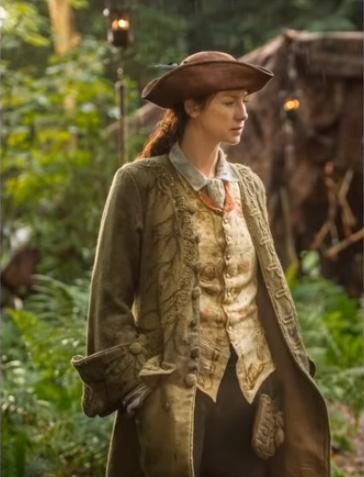
Terry Dresbach said, “There is nothing greater, than a woman wearing men's clothing. Cait so embraced and reveled in the freedom given to Claire, and to herself, after both of them being trapped for months in heavy woolen women's clothing”.
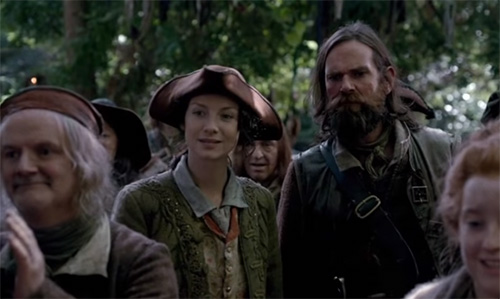
Here's a great behind-the-scenes shot of Caitriona Balfe and her body-double. Notice that the costumes are identical in every way, down to the missing button on the coat.
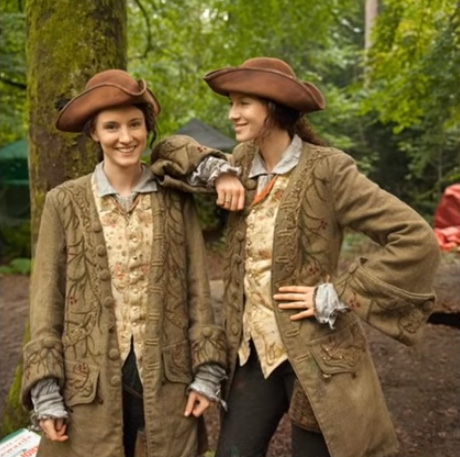
Here is a studio shot of the costume.
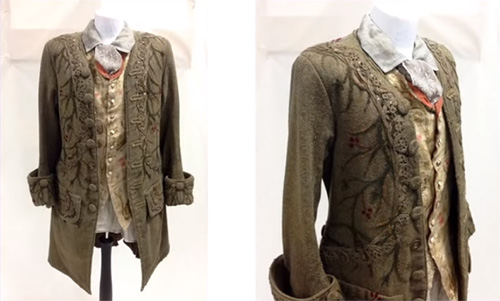
Terry Dresbach said, “This was also the first costume the amazingly talented textile artist, Hellen Gallogly, painted for us, after joining our team. She does beautiful work, and is creating truly startling textiles for us in Season 2”.
This image features a detail from the coat. Dresbach said, “… and the equally talented Emily Watson created that felted embroidery on the coat. How fantastic is that”.
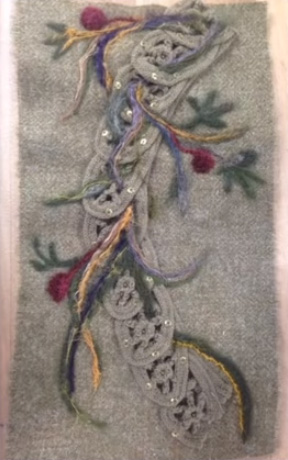
In these two images, Terry Dresbach compares the aging process. On the left, is Claire's waistcoat before aging, and on the right, after aging.
She says, “My team did a phenomenal job of aging this piece. We shredded it and then darned it”.
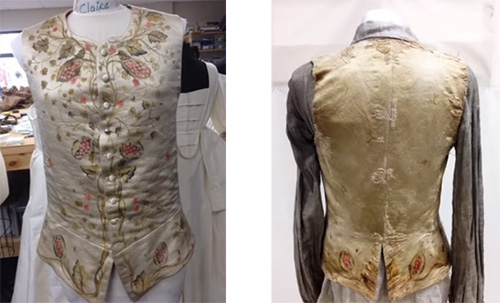
You can see some of the darns in this picture.
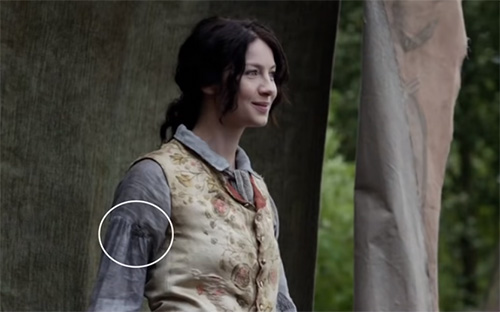
For Claire's Season 1 finale costume, Dresbach describes on her blog how her team were already knee-deep in Season 2 costumes and had lost their cutters and were just rotating through cutters, when they had to make a decision about this dress.
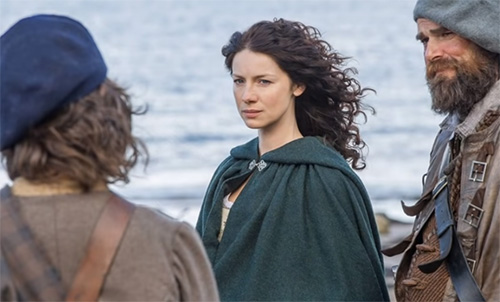
She said, “I remembered that we still had one of the very first costumes we had ever made for Claire somewhere in the racks. I think it was the second costume we'd made for her, and for some reason we decided not to use it, and never finished it”.
“We dug it up and found our solution. We could finish it without having to design and cut an entirely new gown. And it was actually quite perfect for a traveling costume, procured for Claire by the monks. A pretty gown, but nothing spectacular. It was completely believable that it would have belonged to someone else”, adds Terry Dresbach.
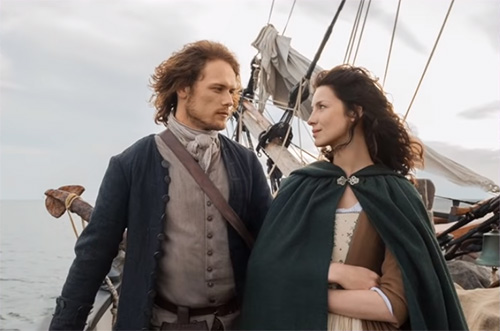
She also said, “One of the things I loved best about this gown was the lovely embroidered stomacher we had made. It came from a piece of embroidered fabric we picked up shopping at the Portobello Market in London. It was also one of the first examples I had seen of metal plate embroidery, which I had completely fallen in love with, and we ultimately used on Claire's wedding dress”.
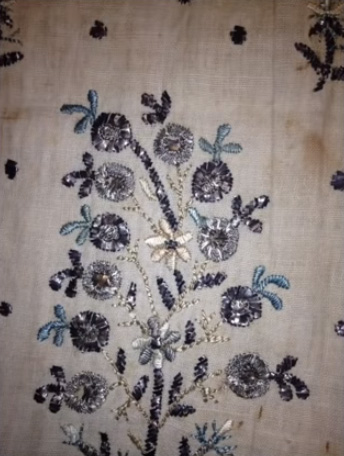
And interestingly, you can see some stains on the linen embroidered fabric.
Terry Dresbach comments, “We didn't even have an embroidery team at that point in the very beginning of Season 1. But Liz Boulton had let me in on her skill as a historical embroiderer. I asked if she could embroider a petticoat to match the piece of antique fabric, and we ended up with a very sweet gown. It was perfect for embarking on a new life in France”.
In this picture, the embroidered fabric is upside down, with the flowers hanging downward.

Here's a picture of the completed costume without the cloak.
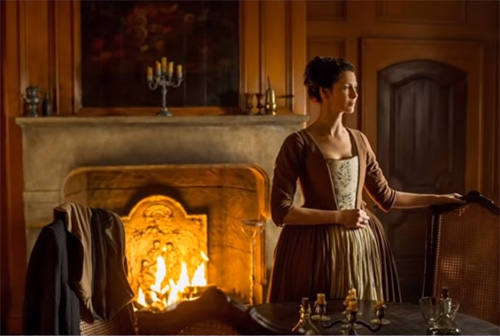
And in this shot from Season 2, you can see the embroidery on the skirt that Liz Boulton matched up to the bodice. And also, this pretty blue-green hooded cloak, a similar shorter version of her tartan-lined cape.

And that is all for the Season 1 of Outlander series. These were Claire Fraser’s best and most interesting outfits from the first season.
Read also:
Stage costumes of Outlander series. Scottish outfits of Claire Fraser in Season 1
Stage costumes of Outlander series, season 1. Scottish folk clothing on Jamie Fraser
Stage costumes of Outlander series. Women’s Scottish outfits used in this movie
Stage costumes of Outlander series. Men’s Scottish clothing used in this movie
(c)


